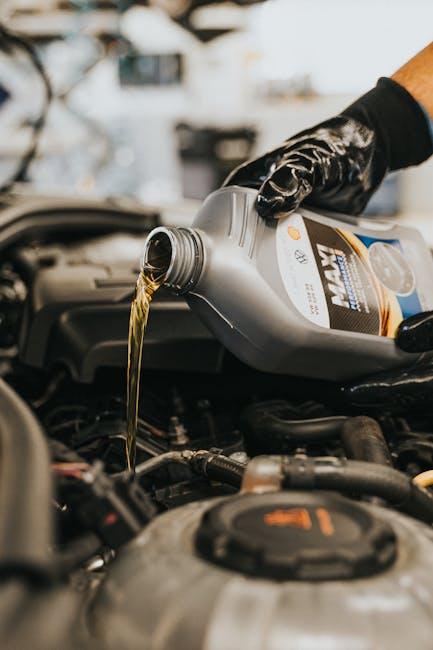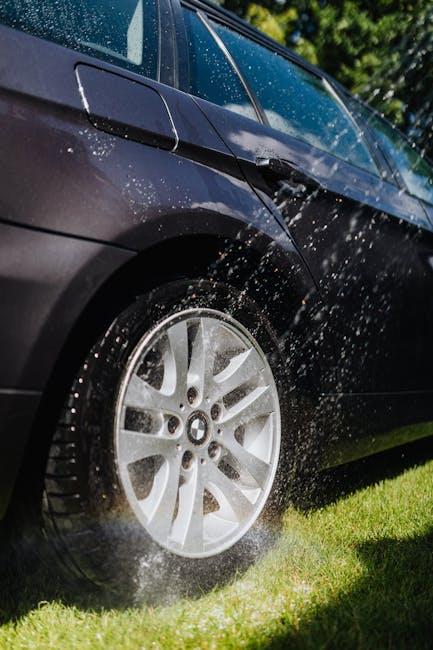Your car is more than just a machine; it’s a companion on countless journeys, a trusted partner that carries you through daily errands and epic adventures alike. Like any trusty companion, it deserves care and attention to thrive for years to come. Increasing the lifespan of your car isn’t just about saving money—it’s about preserving reliability, safety, and the joy of the ride. In this article, we explore practical, easy-to-implement strategies that will help keep your vehicle running smoothly, mile after mile, turning the road ahead into a long-lasting journey.
Table of Contents
- Essential Maintenance Practices to Keep Your Car Running Smoothly
- Choosing the Right Fluids and Filters for Optimal Engine Health
- Tire Care and Alignment Tips for Prolonged Wear and Safety
- Driving Habits That Can Extend Your Vehicle’s Life
- Protecting Your Car from Environmental Damage
- Smart Storage Solutions for Long-Term Vehicle Preservation
- Q&A
- In Summary

Essential Maintenance Practices to Keep Your Car Running Smoothly
To ensure your vehicle keeps performing at its best, regular check-ups and basic upkeep go a long way. Start with consistent oil changes, as fresh oil reduces friction and prevents engine wear. Equally important is maintaining proper tire pressure, which not only improves fuel efficiency but also ensures even tire wear. Don’t overlook the replacement schedules for belts, hoses, and air filters, as they play critical roles in your car’s overall health and can prevent unexpected breakdowns.
In addition to routine checks, developing a habit of visually inspecting your car can alert you to minor issues before they escalate. Look out for leaks, unusual sounds, and warning lights on your dashboard. Use the table below as a handy guideline for maintenance intervals to stay ahead:
| Maintenance Task | Recommended Frequency |
|---|---|
| Oil Change | Every 5,000 to 7,500 miles |
| Tire Rotation | Every 6,000 to 8,000 miles |
| Brake Inspection | Every 12,000 miles |
| Air Filter Replacement | Every 15,000 to 30,000 miles |
| Coolant Flush | Every 30,000 miles or 2 years |
- Monitor fluid levels regularly, including brake, transmission, and power steering fluids.
- Keep the exterior and undercarriage clean to prevent rust and corrosion.
- Address small fixes promptly to avoid costly repairs down the road.

Choosing the Right Fluids and Filters for Optimal Engine Health
Maintaining your engine’s vitality hinges on selecting the right fluids and filters. Engine oil, for instance, is far from a one-size-fits-all solution. Using the oil viscosity and grade recommended by your car’s manufacturer ensures optimal lubrication and heat regulation. Synthetic oils, while pricier, offer advanced protection, especially under extreme temperatures or heavy driving conditions. Alongside oil, coolants must be chosen carefully, balancing corrosion inhibitors and freeze protection to keep the engine’s temperature in check and prevent costly overheating or freezing damage.
Filters play a silent yet critical role in engine longevity. Air filters guard your engine against dust, dirt, and debris, ensuring clean airflow for combustion efficiency. Meanwhile, fuel filters keep contaminants out of your fuel system, preventing clogging and poor performance. To illustrate, here’s a quick reference guide for key fluid and filter types:
| Component | Recommended Type | Maintenance Tip |
|---|---|---|
| Engine Oil | Synthetic 5W-30 or 10W-40 (manufacturer’s spec) | Change every 5,000-7,500 miles |
| Coolant | Ethylene glycol-based, mixed with distilled water | Flush every 2 years or 30,000 miles |
| Air Filter | OEM or high-quality aftermarket | Inspect every 12,000 miles; replace as needed |
| Fuel Filter | OEM recommended for your car model | Replace every 20,000-30,000 miles |
Regularly updating fluids and filters according to these guidelines can dramatically reduce wear, improve fuel efficiency, and extend the engine’s operational life. Don’t overlook the importance of quality components—it’s an investment that pays dividends in performance and reliability.

Tire Care and Alignment Tips for Prolonged Wear and Safety
Maintaining your tires is a cornerstone of vehicle longevity and road safety. Regularly inspecting your tire pressure, tread depth, and ensuring even wear can prevent unexpected blowouts and improve fuel efficiency. Utilize a reliable tire pressure gauge to check levels monthly, adjusting based on manufacturer recommendations. Rotating your tires every 6,000 to 8,000 miles balances wear across all wheels, extending their usability and enhancing driving stability. Additionally, avoid overloading your vehicle, as excess weight can cause premature tire stress and damage.
Alignment plays an equally critical role in how your tires perform and wear over time. Misaligned wheels can cause uneven tread wear, pulling to one side, and increased fuel consumption. Regular alignment checks—ideally during tire rotations—ensure your car maintains optimal contact with the road. Below is a quick reference for common signs indicating alignment issues:
| Symptom | Possible Cause | Recommended Action |
|---|---|---|
| Steering wheel drift | Wheel misalignment | Get professional alignment |
| Uneven tire wear | Suspension or alignment issue | Inspect suspension & align wheels |
| Vehicle pulling to one side | Incorrect toe or camber settings | Adjust alignment settings |
- Pro Tip: Combine tire rotation and alignment checks to save time and maintain optimal performance.
- Visual Cue: Look for feathered tread edges or unusual vibration while driving.
- Safety First: Proper tire health boosts braking efficiency and handling in all weather conditions.

Driving Habits That Can Extend Your Vehicle’s Life
Adopting mindful driving techniques can dramatically increase the longevity of your vehicle’s components. For instance, sudden acceleration and harsh braking put unnecessary strain on the engine, transmission, and brake systems. Instead, aim for smooth starts and stops to keep these parts functioning smoothly for longer. Regularly monitoring your speed on highways and avoiding excessive idling can also reduce wear and fuel consumption, preserving both your engine health and your fuel budget.
Incorporating simple everyday habits can make all the difference:
- Warm up your engine gently before hitting high speeds, especially in cold weather.
- Use cruise control on open roads to maintain steady speed and optimize fuel efficiency.
- Avoid overloading your car, as extra weight strains the suspension and braking systems.
- Steer clear of potholes and rough terrain to protect tires and alignment.
| Driving Habit | Benefit |
|---|---|
| Smooth Acceleration | Reduces engine & transmission wear |
| Steady Speed | Improves fuel economy |
| Gentle Braking | Extends brake pad lifespan |
| Avoid Overloading | Protects suspension system |

Protecting Your Car from Environmental Damage
Environmental elements such as UV rays, acid rain, and road salt can silently degrade your vehicle’s appearance and mechanical integrity over time. To stave off these unseen aggressors, consider investing in a quality car cover or parking under shade whenever possible. Regular applications of a high-grade wax not only add a glossy finish but also create a protective barrier against harmful sun exposure and moisture. Additionally, washing your car frequently—especially after exposure to harsh weather or salty roads—helps prevent corrosive buildup that can lead to rust and paint damage.
Another crucial layer of defense involves protecting your car’s undercarriage and exposed components. Using rust inhibitors on metal parts, particularly before winter months, can drastically reduce the risk of corrosion. Combine this with routine checks of your vehicle’s seals and weatherstripping to avoid water intrusion that may cause interior damage or electrical issues. Below is a quick reference table outlining top preventative measures and their benefits:
| Preventative Measure | Key Benefit | Ideal Frequency |
|---|---|---|
| Car Cover Use | Blocks UV, dirt, and moisture | Daily if outdoors |
| Waxing | Protects paint and adds shine | Every 3 months |
| Rust Inhibitor Treatment | Prevents corrosion | Annually, before winter |
| Frequent Washing | Removes harmful debris and salt | Biweekly or after storms |

Smart Storage Solutions for Long-Term Vehicle Preservation
Preserving a vehicle for the long haul demands more than routine maintenance; it also hinges on intelligent storage techniques. Opting for a climate-controlled environment shields your car from the damaging effects of humidity and extreme temperatures, which can accelerate wear on both the exterior paint and internal components. A garage equipped with proper ventilation minimizes the risk of rust and mold, while UV-blocking window films protect the dashboard and upholstery from fading. Moreover, placing your car on specialized car lifts or blocks avoids unnecessary strain on tires and suspension.
Beyond just shelter, organizing storage with thoughtful accessories boosts longevity:
- Breathable car covers prevent moisture buildup while guarding against dust and debris.
- Tire cradles distribute weight evenly, preventing flat spots during prolonged inactivity.
- Battery maintainers ensure your engine power stays steady without overcharging risks.
| Storage Element | Benefit | Recommended Use |
|---|---|---|
| Climate Control | Prevents condensation & corrosion | Ideally 50°F – 70°F with low humidity |
| Breathable Car Cover | Protects paint and ventilation | Daily or seasonal covers |
| Tire Cradles | Prevents tire deformation | Vehicles stored >30 days |
Q&A
Q: What are the most effective ways to increase the lifespan of my car?
A: To extend your car’s life, prioritize regular maintenance such as oil changes, tire rotations, and brake checks. Driving gently—avoiding rapid acceleration and hard braking—also reduces wear. Keeping your car clean and protecting it from harsh weather helps prevent rust and deterioration.
Q: How often should I service my car to keep it in good condition?
A: Follow the manufacturer’s recommended service schedule, usually found in your owner’s manual. Typically, this means servicing every 5,000 to 7,500 miles. Timely oil changes, fluid top-ups, and inspections catch small problems before they become costly repairs.
Q: Does driving style really impact my car’s longevity?
A: Absolutely. Smooth acceleration, gradual braking, and avoiding high speeds lessen strain on the engine and transmission. Aggressive driving increases wear and tear on key components, shortening the vehicle’s overall lifespan.
Q: Can choosing the right tires improve my car’s durability?
A: Yes. Tires suited to your driving conditions enhance safety and reduce uneven wear, which affects suspension and steering. Proper inflation and regular rotation also prolong tire life and contribute to smoother rides, lowering stress on the entire vehicle.
Q: Is it worth investing in rust prevention?
A: Definitely. Rust can silently eat away at your car’s structure and reduce resale value. Regular washing, especially in winter if salt is used on roads, plus occasional anti-rust treatments, help preserve the metal bodywork and chassis.
Q: How important is it to fix minor problems promptly?
A: Very important. Small issues like a leaking fluid or strange noises are often early warning signs. Ignoring them risks bigger breakdowns that cost more and shorten the car’s useful life. Early repairs keep your vehicle running smoothly longer.
Q: What role does proper storage play in a car’s lifespan?
A: Storing your car in a garage or sheltered area protects it from extreme temperatures, sun damage, and environmental debris. If indoor storage isn’t an option, use a quality car cover to shield the paint and interior. This reduces aging and deterioration over time.
Q: Can upgrading parts help a car last longer?
A: Sometimes. Replacing worn components with high-quality or performance upgrades—like better brake pads, filters, or suspension parts—can improve reliability and efficiency. However, always consider compatibility and cost-effectiveness before investing in upgrades.
Q: How does regular cleaning affect a car’s longevity?
A: Routine cleaning removes dirt, grime, and corrosive substances that can damage paint, undercarriage, and seals. A clean car is easier to inspect for damage and leaks, encouraging proactive maintenance and preserving both function and aesthetics.
Q: What mindset should car owners adopt to maximize vehicle lifespan?
A: Think of your car as a long-term partner rather than a disposable tool. Regular attention, mindful driving, and timely care build a relationship where your vehicle consistently delivers reliability, safety, and value for many years.
In Summary
In the journey of a car’s life, each mile tells a story of care, attention, and mindful driving. Increasing your vehicle’s lifespan isn’t just about preserving metal and machinery—it’s about extending the bond between you and your trusted companion on the road. By committing to regular maintenance, gentle handling, and thoughtful upgrades, you’re not only investing in the longevity of your car but also in the countless memories waiting to unfold. After all, a well-loved car is a testament to time well spent and journeys well taken. Drive wisely, maintain consistently, and watch your car thrive for years to come.
